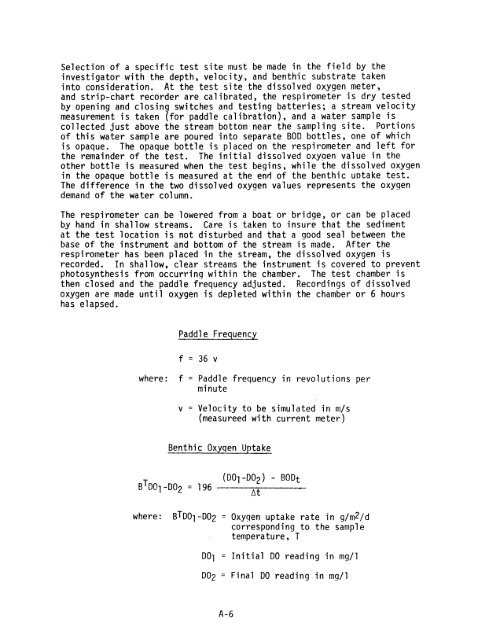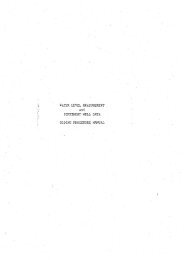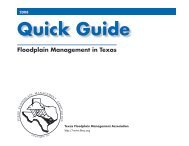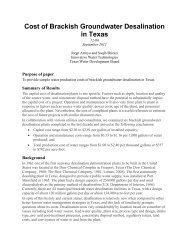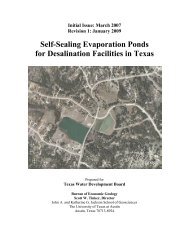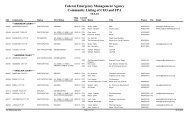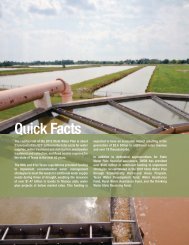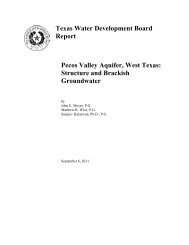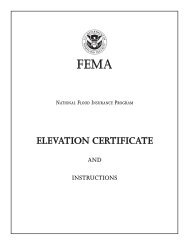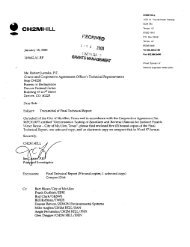Intensive Survey of the Guadalupe River Segment 1806
Intensive Survey of the Guadalupe River Segment 1806
Intensive Survey of the Guadalupe River Segment 1806
You also want an ePaper? Increase the reach of your titles
YUMPU automatically turns print PDFs into web optimized ePapers that Google loves.
Selection <strong>of</strong> a specific test site must be made in <strong>the</strong> field by <strong>the</strong><br />
investigator with <strong>the</strong> depth, velocity, and benthic substrate taken<br />
into consideration. At <strong>the</strong> test site <strong>the</strong> dissolved oxygen meter,<br />
and strip-chart recorder are calibrated, <strong>the</strong> respirometer is dry tested<br />
by opening and closing switches and testing batteries; a stream velocity<br />
measurement is taken (for paddle calibration), and a water sample is<br />
collected just above <strong>the</strong> stream bottom near <strong>the</strong> sampling site. Portions<br />
<strong>of</strong> this water sample are poured into separate BOD bottles, one <strong>of</strong> which<br />
is opaque. The opaque bottle is placed on <strong>the</strong> respirometer and left for<br />
<strong>the</strong> remainder <strong>of</strong> <strong>the</strong> test. The initial dissolved oxygen value in <strong>the</strong><br />
o<strong>the</strong>r bottle is measured when <strong>the</strong> test begins, while <strong>the</strong> dissolved oxygen<br />
in <strong>the</strong> opaque bottle is measured at <strong>the</strong> end <strong>of</strong> <strong>the</strong> benthic uDtake test.<br />
The difference in <strong>the</strong> two dissolved oxygen values represents <strong>the</strong> oxygen<br />
demand <strong>of</strong> <strong>the</strong> water column.<br />
The respirometer can be lowered from a boat or bridge, or can be placed<br />
by hand in shallow streams. Care is taken to insure that <strong>the</strong> sediment<br />
at <strong>the</strong> test location is not disturbed and that a good seal between <strong>the</strong><br />
base <strong>of</strong> <strong>the</strong> instrument and bottom <strong>of</strong> <strong>the</strong> stream is made. After <strong>the</strong><br />
respirometer has been placed in <strong>the</strong> stream, <strong>the</strong> dissolved oxygen is<br />
recorded. In shallow, clear streams <strong>the</strong> instrument is covered to prevent<br />
photosyn<strong>the</strong>sis from occurring within <strong>the</strong> chamber. The test chamber is<br />
<strong>the</strong>n closed and <strong>the</strong> paddle frequency adjusted. Recordings <strong>of</strong> dissolved<br />
oxygen are made until oxygen is depleted within <strong>the</strong> chamber or 6 hours<br />
has elapsed.<br />
Paddle Frequency<br />
f = 36 v<br />
where: f = Paddle frequency in revolutions per<br />
minute<br />
Velocity to be simulated in m/s<br />
(measureed with current meter)<br />
Benthic Oxygen Uptake<br />
BTD01-D02 = 196<br />
(D0i-D02) - B0Dt<br />
where: BTDO1-DO2 = Oxygen uptake rate in g/m2/d<br />
corresponding to <strong>the</strong> sample<br />
temperature, T<br />
At<br />
DO] = Initial DO reading in mg/1<br />
DO2 = Final DO reading in mg/1<br />
A-6


